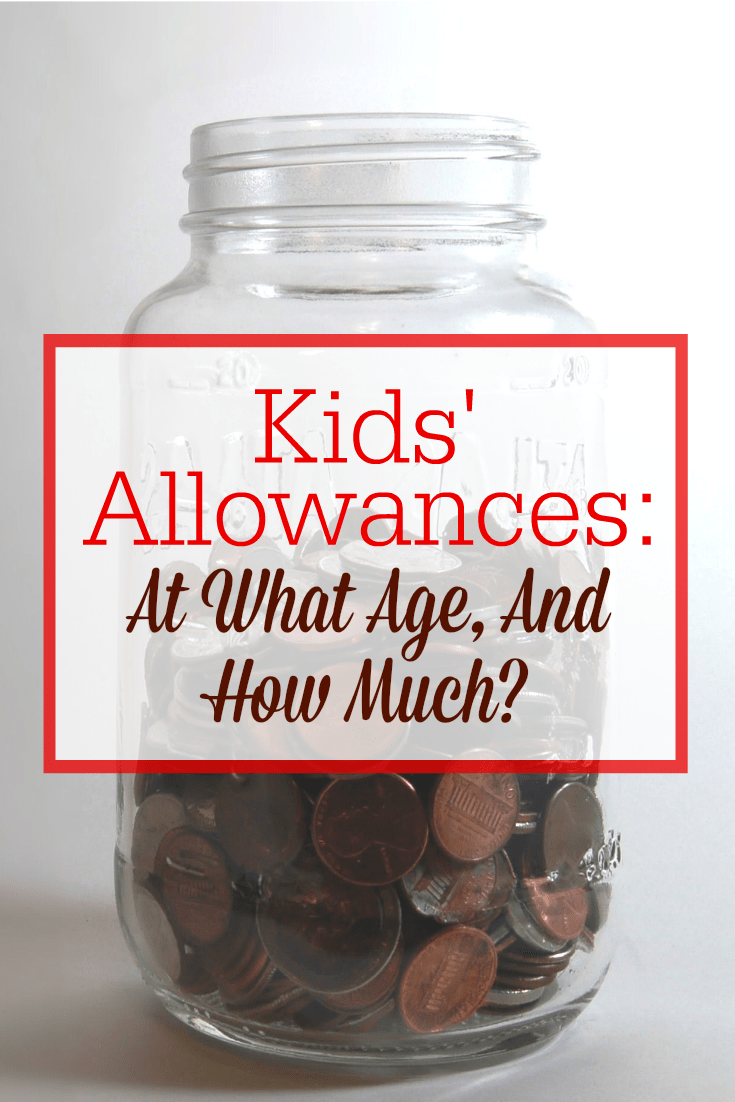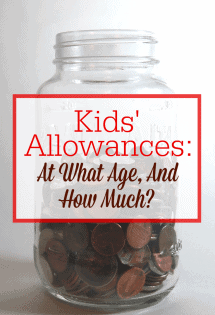Teaching your children how to give, save and spend money all starts with an allowance. But when it comes to kids’ allowances, at what age should you start giving? And how much?

By Jessica Smartt, Contributing Writer
Have you implemented an allowance system for your kids? Do you ever wonder how much kids should get? Is anything too much … or too little? And when should you start?
I have asked myself that question frequently as my kids are now 7 and 5. I guess I always assumed we would do an allowance system, but I didn’t know how at what age we would begin.
Honestly, my motivation for starting was simple.
- I wanted my kids to have money to give.
- I wanted my kids to understand (forgive my old people talk) the value of a dollar.
When are kids are ready for an allowance?
I have heard of people implementing allowance at ages 3 or 4, but I feel that my children wouldn’t have understood much at that age. How do you know if your kids are ready?
I knew my kids were ready, because they were expressing interest in those things I listed above:
- They wanted to give money to people in need.
- They wanted STUFF. And they had no clue how much it cost.
Many people want their small children to have money to put the offering plate. We never did that regularly, but I think at the earlier ages, simply giving them a coin or a dollar prior to church is all that they need.

How much allowance should you give your kids?
When you know your child is ready for allowance, then how much?
Ah, that’s the question. After mulling over this question, I have a very simple answer:
The smallest possible amount.
For the younger ages (lower elementary), that means – brace yourselves – $1 a week. Could you go even less?! Maybe! If you’re implementing allowance for the first time, here are a few tips:
- Vary the denominations. Use dollar bills sometimes, and coins sometimes.
- Consider allowing them to decide for themselves how much to give away instead of mandating an amount. Remember, God loves a cheerful giver. They may surprise you with their generosity.
- Check out a partitioned piggy bank, or at least a separate place for them to put some of their “saving” portion.
- Don’t necessarily tie the allowance to chores that have to be done. (“No allowance unless all your chores are done!!”) This was something I have tweaked since I began allowance. We give our kids chores, but their allowance is theirs, whether or not every single chore has been completed every single day. To be honest, this gives me as a mom a break. Sometimes life gets crazy and chores don’t get done. When I give them their allowance, I say something cheesy like, “I’m glad you’re in our family. Thank you for helping to do your chores. Here’s your allowance!” They get a kick of out of it.
- If you want to take the work / reward concept a step farther, consider adding a simple chore-for-money jar. Again, I’m a big believer in simple. All the chores are $.50; draw one out of the glass and do it.
For more ideas about kids, chores, and money, check out this chore system for young kids–that works!







Lisa @ This Pilgrim Life
We just started giving our two oldest kids an allowance this year. My oldest was 5 at the time and his younger brother was 4. Both of them had started to show a BIG interest in acquiring new lego sets and we wanted them to be able to save money and work towards a goal, rather than simply handing them new things or telling them only for birthdays or Christmas. We have not been very consistent with giving them their allowance because having a newborn means I’m not consistent with much right now. But I do want to start the routine back. I also need to figure out a better system for what they save and give. I like your idea to let them have input in that. I think I will try that when we start back. Oh, and we gave them each $2 just because after saving some and giving some, we didn’t want it to take forever for them to have enough for a lego set. They are also given the opportunity to earn more by doing extra jobs around the house and for family members.
Jessica Smartt
Lisa, I struggle with that a little, too…Unless you want them to only buy little trinkets, everything costs SO MUCH! 🙁 ps – I’m totally going to read over your latest post. I need some ideas for Ellie when school starts!!
Alexa
We follow Dave Ramsey’s system and call it a commission. They tithe at least 10%, save 20%, and can spend 70%. I like the commission idea because as an adult they wont be given money for nothing and we dont want them to think we pay them to be in the family. There are chores that dont recieve a commission because they are simply part of being a family.
Jill
NO NO NO to tying an allowance to chores. When you’re in a family, everyone has to do their part to help out the collective. You don’t get paid for that. I get so frustrated with any method that reinforces the idea that you only do the right thing if there’s a reward waiting for you.
But Yes to allowances in general. I sit each kid down and give them five singles. They must immediately give me one back which goes in my pocket. We’ve explained that mom and dad earn money, but that we pay taxes which is money used for the good of all. (I also want them to feel that “pain” of seeing their gross pay….then seeing their after tax pay, like we grown ups do.) They also have to immediately take another dollar and put it in our church envelope for the week. This teaches them that money is a blessing and that we are to give back to those less fortunate or to the church.
They must put another dollar in their piggy banks, which I keep. This is to teach them that saving is important. We periodically count what’s in their banks so that they can appreciate how savings build up over time.
The other two dollars are theirs to do with as they wish. We do not use “no allowance” as a punishment either.
Jessica Smartt
Taxes! LOL! That’s great to teach that painful lesson early 😉 In all seriousness, I like your $5 idea! One thing that’s been tricky about just $1 is it’s not easy to split…
Becca
We tie allowance to chores. Not all chores; but some. (If the kids complain about having to do a chore without getting paid for it, I respond, “Well, you give me a dollar and I’ll do it for you.”) I know there are people who feel strongly against linking chores with allowance; and that’s fine; everyone will do what they feel is best for their family. But for us, we didn’t want them just getting money for nothing. We don’t require them to save or to give anything to charity; as adults we get to make those choices for ourselves, they aren’t forced on us, so we don’t want to force them on our kids either. We are both very good with money and we hope that allowances will allow our kids to make mistakes with money while they are young and it doesn’t matter. One child is a great saver; the other is constantly in debt because she’s spent all of her money and borrowed from her brother! Hopefully she gets tired of being poor and starts saving a bit better. (He should start charging interest. That’d drive the message home!)
The best side-effect of allowances: No more nagging! If the kids see something they like at the store, they know our answer will be, “Well, save your money.”
Jessica Smartt
Becca, I see what you’re saying about the chores. And I like that reply – “Give me a dollar and I’ll do it.” 😉
Jess
Giving an allowance for chores is teaching you work hard in life it will be rewarded. Also teaching them how to be responsible with their money for when they are older. Also I was not given pocket money for chores growing up and just given money for bus rides to the mall with friends which I didn’t work for. Means if we go on holiday their spending money is from their chores they will spend this more wisely as they worked hard for it.
Erin
I give monthly allowance by their age, starting at 2. My 2 year old likes to have money to give and spend just like her big sister who is 6. My 2 wanted Girl Scout cookies and I let her pick out her box an pay with her money which she helped count it, it helps teach her math but also makes her feel like a big girl. My 6 year old saves her allowance for things she wants or if she wants to donate it. But we also let her choose a place on her birthday to donate items to and she does the shopping with a budget and we started that at 5 it teaches her to give back. Chores aren’t paid for in our house because she has responsibilities as being a family member and she has responsibilities to clean up after herself.